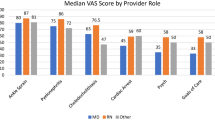Abstract
Background
The underuse of interpreters for limited English proficiency (LEP) patient encounters is pervasive, particularly in the emergency department (ED).
Objective
To measure the outcome of strategies to improve the use of interpreters by ED providers.
Methods
Pre- and post- intervention evaluation of the unmet need for language assistance (LA) in a public ED. Informed by the Behavior Change Wheel (BCW), strategies included: education, training, technology-based facilitators, local champions and environmental cues.
Results
Pre-intervention, of the 110 patient charts with interpreter requests, 17 (15.5%) had documentation of an interpreter-mediated encounter or were seen by a certified bilingual provider (unmet need = 84.5%). Post intervention, of the 159 patient charts with interpreter requests, 47 (29.6%) had documentation of an interpreter-mediated encounter or were seen by a certified bilingual provider (unmet need = 70.4%), difference + 0.14 (95% CI = 0.03-0.23).
Conclusion
In this pilot study, we found a statistically significant increase in the met need for language assistance.


Similar content being viewed by others
References
Ryan C. Language use in the United States: 2011. In: Bureau USC, editor. 2013
Chen AH, Youdelman MK, Brooks J. The legal framework for language access in healthcare settings: title VI and beyond. J Gen Intern Med. 2007;22(Suppl 2):362–7.
Diamond LC, Schenker Y, Curry L, Bradley EH, Fernandez A. Getting by: underuse of interpreters by resident physicians. J Gen Intern Med. 2009;24(2):256–62.
Ramirez D, Engel KG, Tang TS. Language interpreter utilization in the emergency department setting: a clinical review. J Health Care Poor Underserved. 2008;19(2):352–62.
Lee KC, Winickoff JP, Kim MK, Campbell EG, Betancourt JR, Park ER, et al. Resident physicians’ use of professional and nonprofessional interpreters: a national survey. Jama. 2006;296(9):1050–3.
Lindholm M, Hargraves JL, Ferguson WJ, Reed G. Professional language interpretation and inpatient length of stay and readmission rates. J Gen Intern Med. 2012;27(10):1294–9.
Ngai KM, Grudzen CR, Lee R, Tong VY, Richardson LD, Fernandez A. The association between limited English proficiency and unplanned emergency department revisit within 72 hours. Ann Emerg Med. 2016;68(2):213–21.
Samuels-Kalow ME, Stack AM, Porter SC. Parental language and dosing errors after discharge from the pediatric emergency department. Pediatr Emerg Care. 2013;29(9):982–7.
Karliner LS, Jacobs EA, Chen AH, Mutha S. Do professional interpreters improve clinical care for patients with limited English proficiency? A systematic review of the literature. Health Serv Res. 2007;42(2):727–54.
Flores G. The impact of medical interpreter services on the quality of health care: a systematic review. Med Care Res Rev. 2005;62(3):255–99.
The Joint Commission. Advancing effective communication, cultural competence, and patient- and family-centered care: a roadmap. Oakbrook Terrace: The Joint Commission; 2010.
Betancourt JRRM, Green AR, et al. Improving patient safety systems for patients with limited English proficiency: a guide for hospitals. Rockville: Agency for Healthcare Research and Quality; 2012. Contract No.: AHRQ No. 12-0041
Section 1557: ensuring meaningful access for individuals with limited English proficiency: health and human services; 2010. Available from: https://www.hhs.gov/sites/default/files/1557-fs-lep-508.pdf
Baker DW, Parker RM, Williams MV, Coates WC, Pitkin K. Use and effectiveness of interpreters in an emergency department. Jama. 1996;275(10):783–8.
Taira BR, Kim K, Mody N. Hospital and health system-level interventions to improve care for limited English proficiency patients: a systematic review; 2018
Taira BR, Orue A. Language assistance for limited English proficiency patients in a public ED: determining the unmet need. BMC Health Serv Res. 2019;19(1):56.
Kwoh S. LA speaks: language diversity and English proficiency by Los Angeles County service planning area
Handley MA, Gorukanti A, Cattamanchi A. Strategies for implementing implementation science: a methodological overview. Emerg Med J. 2016;33(9):660–4.
Glanz K, Bishop DB. The role of behavioral science theory in development and implementation of public health interventions. Annu Rev Public Health. 2010;31:399–418.
Taira BR, Torres J, Nguyen A, Guo R, Samra S. Language assistance for the care of Limited English Proficiency (LEP) patients in the emergency department: a survey of providers and staff. J Immigr Minor Health. 2020;22(3):439–47.
Michie S, van Stralen MM, West R. The behaviour change wheel: a new method for characterising and designing behaviour change interventions. Implement Sci. 2011;6:42.
Taira BR. Language. http://www.idheal-ucla.org/2017. Available from: http://www.idheal-ucla.org/page-45/page-12/page-17/
Tang AS, Kruger JF, Quan J, Fernandez A. From admission to discharge: patterns of interpreter use among resident physicians caring for hospitalized patients with limited English proficiency. J Health Care Poor Underserved. 2014;25(4):1784–98.
Ginde AA, Sullivan AF, Corel B, Caceres JA, Camargo CA Jr. Reevaluation of the effect of mandatory interpreter legislation on use of professional interpreters for ED patients with language barriers. Patient Educ Couns. 2010;81(2):204–6.
Yawman D, McIntosh S, Fernandez D, Auinger P, Allan M, Weitzman M. The use of Spanish by medical students and residents at one university hospital. Acad Med. 2006;81(5):468–73.
Detailed languages spoken at home and ability to speak English for the population 5 years and over: 2009–2013: United States Census Bureau; 2015. Available from: https://www.census.gov/data/tables/2013/demo/2009-2013-lang-tables.html
Taira BR, Kim K, Mody N. Hospital and health system-level interventions to improve care for limited English proficiency patients: a systematic review. Jt Comm J Qual Patient Saf. 2019;45(6):446–58.
Smedley BD, Stith AY, Nelson AR. In: Medicine Io, editor. Unequal treatment: confronting racial and ethnic disparities in health care. Washington, DC: The National Academies Press; 2003.
Acknowledgements
Redcap access was supported by NIH/National Center for Advancing Translational Science (NCATS) UCLA CTSI Grant Number UL1TR000124.
Author information
Authors and Affiliations
Corresponding author
Ethics declarations
Conflict of interest
The authors have no conflicts of interest to disclose.
Informed Consent
This study was approved by the Olive View-UCLA IRB and granted a waiver of written informed consent.
Additional information
Publisher’s Note
Springer Nature remains neutral with regard to jurisdictional claims in published maps and institutional affiliations.
Rights and permissions
About this article
Cite this article
Taira, B.R., Onofre, L., Yaggi, C. et al. An Implementation Science Approach Improves Language Access in the Emergency Department. J Immigrant Minority Health 23, 1214–1222 (2021). https://doi.org/10.1007/s10903-020-01127-x
Accepted:
Published:
Issue Date:
DOI: https://doi.org/10.1007/s10903-020-01127-x




